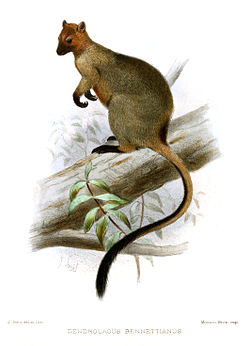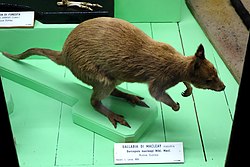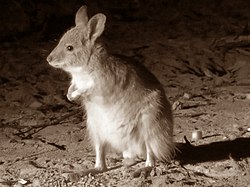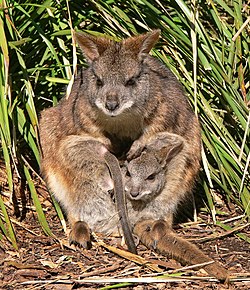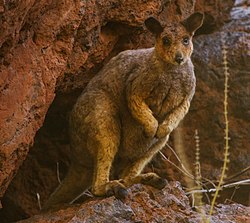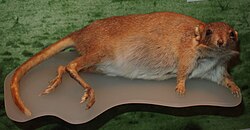Macropodiformes
The following classification is based on the taxonomy described by the reference work Mammal Species of the World (2005), with augmentation by generally accepted proposals made since using molecular phylogenetic analysis, as supported by both the IUCN and the American Society of Mammalogists. [4]
Hypsiprymnodontidae
| Common name | Scientific name and subspecies | Range | Size and ecology | IUCN status and estimated population |
|---|---|---|---|---|
| Musky rat-kangaroo | H. moschatus Ramsay, 1876 | Northeastern Australia | Size: 20–35 cm (8–14 in) long, plus 6–13 cm (2–5 in) tail [5] Habitat: Forest [6] Diet: Insects, as well as worms, tuberous roots, and palm berries [5] | LC
|
Macropodidae
Subfamily Macropodinae
| Common name | Scientific name and subspecies | Range | Size and ecology | IUCN status and estimated population |
|---|---|---|---|---|
| Bennett's tree-kangaroo | D. bennettianus Vis, 1887 | Northeastern Australia | Size: 69–75 cm (27–30 in) long, plus 73–84 cm (29–33 in) tail [7] Habitat: Forest [8] Diet: Leaves and fruit [7] | NT
|
| Dingiso | D. mbaiso Flannery, Szalay & Boeadi, 1995 | Western New Guinea  | Size: 52–81 cm (20–32 in) long, plus 40–94 cm (16–37 in) tail [9] Habitat: Forest and shrubland [10] Diet: Leaves and fruit [11] | EN
|
| Doria's tree-kangaroo | D. dorianus Ramsay, 1883 Two subspecies
| Eastern New Guinea | Size: 41–81 cm (16–32 in) long, plus 40–94 cm (16–37 in) tail [12] Habitat: Forest [13] Diet: Leaves and fruit [11] | VU
|
| Golden-mantled tree-kangaroo | D. pulcherrimus Flannery, 1993 | Northern New Guinea | Size: 41–81 cm (16–32 in) long, plus 40–94 cm (16–37 in) tail [12] Habitat: Forest [14] Diet: Leaves and fruit [11] | CR
|
| Goodfellow's tree-kangaroo | D. goodfellowi Thomas, 1906 Two subspecies
| Eastern New Guinea | Size: 55–77 cm (22–30 in) long, plus 70–85 cm (28–33 in) tail [15] Habitat: Forest [16] Diet: Leaves, fruit, and cereals, as well as flowers and grass [15] | EN
|
| Grizzled tree-kangaroo | D. inustus Müller, 1840 Two subspecies
| Western and northern New Guinea | Size: 41–81 cm (16–32 in) long, plus 40–94 cm (16–37 in) tail [12] Habitat: Forest [17] Diet: Leaves, fruit, and bark [18] | VU
|
| Ifola | D. notatus Matschie, 1916 | Eastern New Guinea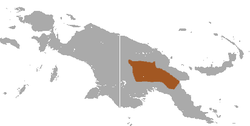 | Size: 41–81 cm (16–32 in) long, plus 40–94 cm (16–37 in) tail [12] Habitat: Forest [19] Diet: Leaves and fruit [11] | EN
|
| Lowlands tree-kangaroo | D. spadix Troughton & Le Souef, 1936 | Eastern New Guinea | Size: 41–81 cm (16–32 in) long, plus 40–94 cm (16–37 in) tail [12] Habitat: Forest [20] Diet: Leaves and fruit [11] | VU
|
| Lumholtz's tree-kangaroo | D. lumholtzi Collett, 1884 | Northeastern Australia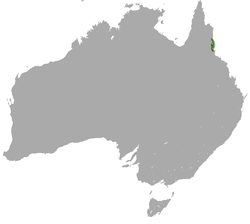 | Size: 41–81 cm (16–32 in) long, plus 40–94 cm (16–37 in) tail [12] Habitat: Forest [21] Diet: A variety of leaves as well as flowers [22] | NT
|
| Matschie's tree-kangaroo | D. matschiei Rothschild & Förster, 1907 | Eastern New Guinea | Size: 55–63 cm (22–25 in) long, plus 55–63 cm (22–25 in) tail [23] Habitat: Forest [24] Diet: Leaves, as well as fruit, flowers, nuts, insects, bark, sap, bird eggs, and young birds [23] | EN
|
| Seri's tree-kangaroo | D. stellarum Flannery & Seri, 1990 | Central New Guinea | Size: 41–81 cm (16–32 in) long, plus 40–94 cm (16–37 in) tail [12] Habitat: Forest [25] Diet: Leaves and fruit [11] | VU
|
| Tenkile | D. scottae Flannery, 1990 | Northern New Guinea | Size: 41–81 cm (16–32 in) long, plus 40–94 cm (16–37 in) tail [12] Habitat: Forest [26] Diet: Tree leaves, ferns, and soft vines [27] | CR
|
| Ursine tree-kangaroo | D. ursinus (Temminck, 1836) | Western New Guinea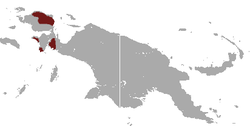 | Size: 41–81 cm (16–32 in) long, plus 40–94 cm (16–37 in) tail [12] Habitat: Forest [28] Diet: Leaves and fruit [11] | VU
|
| Wondiwoi tree-kangaroo | D. mayri Rothschild & Dollman, 1933 | Western New Guinea | Size: 41–81 cm (16–32 in) long, plus 40–94 cm (16–37 in) tail [12] Habitat: Forest [29] Diet: Leaves and fruit [11] | CR
|
| Common name | Scientific name and subspecies | Range | Size and ecology | IUCN status and estimated population |
|---|---|---|---|---|
| Black dorcopsis | D. atrata Deusen, 1957 | Eastern New Guinea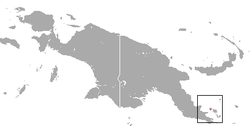 | Size: 73–100 cm (29–39 in) long, plus 28–40 cm (11–16 in) tail [30] Habitat: Forest [31] Diet: Leaves, roots, grass and fruit [30] | CR
|
| Brown dorcopsis | D. muelleri (Lesson, 1827) Four subspecies
| Western New Guinea | Size: 34–97 cm (13–38 in) long, plus 27–55 cm (11–22 in) tail [32] Habitat: Forest [33] Diet: Roots, leaves, grass, and fruit [32] | LC
|
| Gray dorcopsis | D. luctuosa (D'Albertis, 1874) Two subspecies
| Southern New Guinea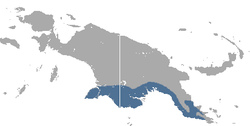 | Size: 34–97 cm (13–38 in) long, plus 27–55 cm (11–22 in) tail [32] Habitat: Forest [34] Diet: Roots, leaves, grass, and fruit [32] | VU
|
| White-striped dorcopsis | D. hageni Heller, 1897 | Northern New Guinea | Size: 34–97 cm (13–38 in) long, plus 27–55 cm (11–22 in) tail [32] Habitat: Forest [35] Diet: Roots, leaves, grass, and fruit [32] | LC
|
| Common name | Scientific name and subspecies | Range | Size and ecology | IUCN status and estimated population |
|---|---|---|---|---|
| Macleay's dorcopsis | D. macleayi (Miklouho-Maclay, 1885) | Eastern New Guinea | Size: 31–46 cm (12–18 in) long, plus 22–41 cm (9–16 in) tail [36] Habitat: Forest [37] Diet: Leaves, buds, and stems [38] | LC
|
| Small dorcopsis | D. vanheurni (Thomas, 1922) | Central and eastern New Guinea | Size: 31–46 cm (12–18 in) long, plus 22–41 cm (9–16 in) tail [36] Habitat: Forest [39] Diet: Believed to be leaves and fruit [36] | NT
|
| Common name | Scientific name and subspecies | Range | Size and ecology | IUCN status and estimated population |
|---|---|---|---|---|
| Eastern hare-wallaby† | L. leporides Gould, 1841 | Southeastern Australia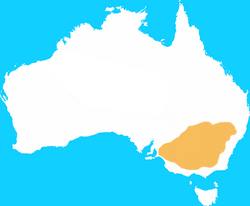 | Size: About 45 cm (18 in) long, plus 32 cm (13 in) tail [40] Habitat: Unknown [41] Diet: Unknown [40] | EX
|
| Lake Mackay hare-wallaby† | L. asomatus Finlayson, 1943 | Central Australia | Size: Unknown [42] Habitat: Desert [43] Diet: Unknown [42] | EX
|
| Rufous hare-wallaby | L. hirsutus Gould, 1844 | Western Australia | Size: 31–39 cm (12–15 in) long, plus 24–31 cm (9–12 in) tail [44] Habitat: Shrubland, grassland [45] Diet: Seeds, fruit, grass, sedges, and succulent shrubs and herbs [44] | NT
|
| Spectacled hare-wallaby | L. conspicillatus Gould, 1842 | Northern Australia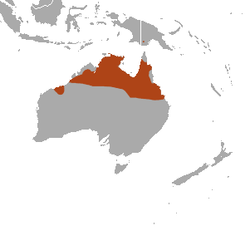 | Size: 39–49 cm (15–19 in) long, plus 37–53 cm (15–21 in) tail [42] Habitat: Forest, savanna, shrubland, and grassland [46] Diet: Grass, forbs, and herbs [42] | LC
|
| Common name | Scientific name and subspecies | Range | Size and ecology | IUCN status and estimated population |
|---|---|---|---|---|
| Eastern grey kangaroo | M. giganteus Shaw, 1790 Two subspecies
| Eastern Australia | Size: 85–140 cm (33–55 in) long, plus 75–100 cm (30–39 in) tail [47] Habitat: Forest, savanna, shrubland, and grassland [48] Diet: Grass, as well as forbs [49] | LC
|
| Western grey kangaroo | M. fuliginosus (Desmarest, 1817) Three subspecies
| Southern and southwestern Australia | Size: 85–140 cm (33–55 in) long, plus 75–100 cm (30–39 in) tail [47] Habitat: Forest, savanna, shrubland, and grassland [50] Diet: Grass, forbs, leaves, tree bark, and shrubs [51] | LC
|
| Common name | Scientific name and subspecies | Range | Size and ecology | IUCN status and estimated population |
|---|---|---|---|---|
| Agile wallaby | N. agilis (Gould, 1842) Four subspecies
| Northern Australia and southern New Guinea | Size: 40–105 cm (16–41 in) long, plus 33–75 cm (13–30 in) tail [52] Habitat: Savanna and grassland [53] Diet: Grass, shrubs, bushes, and roots, as well as leaves and fruit [54] | LC
|
| Black-striped wallaby | N. dorsalis (Gray, 1837) | Northeastern Australia | Size: 40–105 cm (16–41 in) long, plus 33–75 cm (13–30 in) tail [52] Habitat: Forest, savanna, and shrubland [55] Diet: Grass, as well as forbs and shrubs [56] | LC
|
| Parma wallaby | N. parma (Waterhouse, 1846) | Eastern Australia | Size: 44–53 cm (17–21 in) long, plus 40–55 cm (16–22 in) tail [57] Habitat: Forest [58] Diet: Grass and herbs [57] | VU
|
| Red-necked wallaby | N. rufogriseus (Desmarest, 1817) Three subspecies
| Eastern and southeastern Australia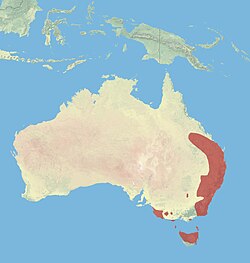 | Size: 92–105 cm (36–41 in) long, plus 70–75 cm (28–30 in) tail [59] Habitat: Forest, shrubland, and grassland [60] Diet: Grass and herbs, as well as roots [59] | LC
|
| Tammar wallaby | N. eugenii (Desmarest, 1817) | Southern and southwestern Australia | Size: 52–68 cm (20–27 in) long, plus 33–45 cm (13–18 in) tail [61] Habitat: Forest and shrubland [62] Diet: Grass as well as shrubs [62] | LC
|
| Toolache wallaby† | N. greyi Waterhouse, 1846 | Southern Australia | Size: 40–105 cm (16–41 in) long, plus 33–75 cm (13–30 in) tail [52] Habitat: Savanna and grassland [63] Diet: Grass, leaves, and roots [64] | EX
|
| Western brush wallaby | N. irma (Jourdan, 1837) | Southwestern Australia | Size: 40–105 cm (16–41 in) long, plus 33–75 cm (13–30 in) tail [52] Habitat: Forest, savanna, and shrubland [65] Diet: Grass [66] | LC
|
| Whiptail wallaby | N. parryi (Bennett, 1835) | Northeastern Australia | Size: 40–105 cm (16–41 in) long, plus 33–75 cm (13–30 in) tail [52] Habitat: Savanna [67] Diet: Grass, ferns, and herbs [68] | LC
|
| Common name | Scientific name and subspecies | Range | Size and ecology | IUCN status and estimated population |
|---|---|---|---|---|
| Antilopine kangaroo | O. antilopinus Gould, 1842 | Northern Australia | Size: 75–140 cm (30–55 in) long, plus 60–90 cm (24–35 in) tail [47] Habitat: Forest, savanna, and grassland [69] Diet: Grass [70] | LC
|
| Black wallaroo | O. bernardus (Rothschild, 1904) | Northern Australia | Size: About 73 cm (29 in) long, plus 64 cm (25 in) tail [71] Habitat: Forest, shrubland, and grassland [72] Diet: Grass and shrubs, as well as other plants [73] | NT
|
| Common wallaroo | O. robustus (Gould, 1841) Four subspecies
| Australia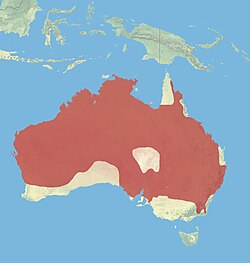 | Size: 75–140 cm (30–55 in) long, plus 60–90 cm (24–35 in) tail [47] Habitat: Forest, savanna, shrubland, and grassland [74] Diet: Grasses and shrubs [74] | LC
|
| Red kangaroo | O. rufus (Desmarest, 1822) | Australia | Size: 85–160 cm (33–63 in) long, plus 65–120 cm (26–47 in) tail [75] Habitat: Savanna, shrubland, grassland, and desert [76] Diet: Grass and flowering plants [75] | LC
|
| Common name | Scientific name and subspecies | Range | Size and ecology | IUCN status and estimated population |
|---|---|---|---|---|
| Bridled nail-tail wallaby | O. fraenata Gould, 1841 | Scattered eastern Australia | Size: 43–70 cm (17–28 in) long, plus 36–73 cm (14–29 in) tail [77] Habitat: Forest, savanna, and shrubland [78] Diet: Variety of forbs, grass, and shrubs [77] | VU
|
| Crescent nail-tail wallaby† | O. lunata (Gould, 1841) | Western Australia | Size: 37–51 cm (15–20 in) long, plus 15–33 cm (6–13 in) tail [79] Habitat: Savanna and grassland [80] Diet: Unknown [79] | EX
|
| Northern nail-tail wallaby | O. unguifera (Gould, 1841) | Scattered northern Australia | Size: 43–70 cm (17–28 in) long, plus 36–73 cm (14–29 in) tail [81] Habitat: Forest, savanna, and shrubland [82] Diet: Herbs, succulents, fruit, and grass [81] | LC
|
| Common name | Scientific name and subspecies | Range | Size and ecology | IUCN status and estimated population |
|---|---|---|---|---|
| Allied rock-wallaby | P. assimilis Ramsay, 1877 | Northeastern Australia | Size: 40–70 cm (16–28 in) long, plus 30–70 cm (12–28 in) tail [83] Habitat: Rocky areas [84] Diet: Grass, leaves, forbs, fruit, flowers, seeds [85] | LC
|
| Black-flanked rock-wallaby | P. lateralis Gould, 1842 Three subspecies
| Scattered central and western Australia | Size: 40–70 cm (16–28 in) long, plus 30–70 cm (12–28 in) tail [83] Habitat: Savanna, shrubland, grassland, rocky areas, and desert [86] Diet: Grass, leaves, forbs, fruit, flowers, seeds [85] | VU
|
| Brush-tailed rock-wallaby | P. penicillata Gray, 1827 | Eastern Australia | Size: 40–70 cm (16–28 in) long, plus 30–70 cm (12–28 in) tail [83] Habitat: Forest, savanna, and rocky areas [87] Diet: Grass, as well as leaves, sedges, ferns, roots, bark, fruit, seeds and flowers [88] | VU
|
| Cape York rock-wallaby | P. coenensis Eldridge & Close, 1992 | Northern Australia | Size: 40–70 cm (16–28 in) long, plus 30–70 cm (12–28 in) tail [83] Habitat: Forest and rocky areas [89] Diet: Grass, leaves, forbs, fruit, flowers, seeds [85] | EN
|
| Godman's rock-wallaby | P. godmani Thomas, 1923 | Northern Australia | Size: 40–70 cm (16–28 in) long, plus 30–70 cm (12–28 in) tail [83] Habitat: Rocky areas [90] Diet: Grass, leaves, forbs, fruit, flowers, seeds [85] | NT
|
| Herbert's rock-wallaby | P. herberti Thomas, 1926 | Eastern Australia | Size: 40–70 cm (16–28 in) long, plus 30–70 cm (12–28 in) tail [83] Habitat: Rocky areas [91] Diet: Grass, leaves, forbs, fruit, flowers, seeds [85] | LC
|
| Mareeba rock-wallaby | P. mareeba Eldridge & Close, 1992 | Northern Australia | Size: 40–70 cm (16–28 in) long, plus 30–70 cm (12–28 in) tail [83] Habitat: Rocky areas [92] Diet: Grass, leaves, forbs, fruit, flowers, seeds [85] | NT
|
| Monjon | P. burbidgei Kitchener, 1978 | Northwestern Australia | Size: 29–36 cm (11–14 in) long, plus 25–33 cm (10–13 in) tail [83] Habitat: Forest and rocky areas [93] Diet: Grass, leaves, forbs, fruit, flowers, seeds [85] | NT
|
| Mount Claro rock-wallaby | P. sharmani Eldridge & Close, 1992 | Northern Australia | Size: 29–36 cm (11–14 in) long, plus 25–33 cm (10–13 in) tail [83] Habitat: Rocky areas [94] Diet: Grass, leaves, forbs, fruit, flowers, seeds [85] | VU
|
| Nabarlek | P. concinna Gould, 1842 | Northwestern Australia | Size: 29–35 cm (11–14 in) long, plus 22–31 cm (9–12 in) tail [95] Habitat: Forest, savanna, grassland, and rocky areas [96] Diet: Grass and ferns [95] | EN
|
| Proserpine rock-wallaby | P. persephone Maynes, 1982 | Northeastern Australia | Size: 40–70 cm (16–28 in) long, plus 30–70 cm (12–28 in) tail [83] Habitat: Forest and rocky areas [97] Diet: Grass and leaves, as well as shrubs, forbs, and fungi [98] | EN
|
| Purple-necked rock-wallaby | P. purpureicollis Le Souef, 1924 | North central Australia | Size: 40–70 cm (16–28 in) long, plus 30–70 cm (12–28 in) tail [83] Habitat: Rocky areas [99] Diet: Grass, leaves, forbs, fruit, flowers, seeds [85] | NT
|
| Rothschild's rock-wallaby | P. rothschildi Thomas, 1904 | Northwestern Australia | Size: 40–70 cm (16–28 in) long, plus 30–70 cm (12–28 in) tail [83] Habitat: Rocky areas [100] Diet: Grass, leaves, forbs, fruit, flowers, seeds [85] | LC
|
| Short-eared rock-wallaby | P. brachyotis (Gould, 1841) | Northern Australia | Size: 40–70 cm (16–28 in) long, plus 30–70 cm (12–28 in) tail [83] Habitat: Forest, savanna, and rocky areas [101] Diet: Grass, as well as bark and roots [102] | LC
|
| Unadorned rock-wallaby | P. inornata Gould, 1842 | Northeastern Australia | Size: 40–70 cm (16–28 in) long, plus 30–70 cm (12–28 in) tail [83] Habitat: Rocky areas [103] Diet: Grass, leaves, forbs, fruit, flowers, seeds [85] | LC
|
| Yellow-footed rock-wallaby | P. xanthopus Gray, 1855 Two subspecies
| South central Australia | Size: 48–65 cm (19–26 in) long, plus 57–70 cm (22–28 in) tail [104] Habitat: Rocky areas [105] Diet: Grass and leaves [104] | NT
|
| Common name | Scientific name and subspecies | Range | Size and ecology | IUCN status and estimated population |
|---|---|---|---|---|
| Quokka | S. brachyurus (Quoy & Gaimard, 1830) | Southwestern Australia | Size: 39–60 cm (15–24 in) long, plus 23–35 cm (9–14 in) tail [106] Habitat: Forest, shrubland, and inland wetlands [107] Diet: Succulents, shrubs, forbs, grasses and sedges, as well as seeds, berries, and fruit [108] | VU
|
| Common name | Scientific name and subspecies | Range | Size and ecology | IUCN status and estimated population |
|---|---|---|---|---|
| Brown's pademelon | T. browni (Ramsay, 1877) | Eastern New Guinea (introduced in red)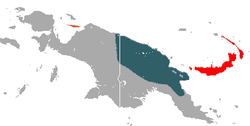 | Size: 29–67 cm (11–26 in) long, plus 24–57 cm (9–22 in) tail [109] Habitat: Forest [110] Diet: Grass, leaves, shoots, seeds, and fruit [111] | VU
|
| Calaby's pademelon | T. calabyi Flannery, 1992 | Scattered eastern New Guinea | Size: 29–67 cm (11–26 in) long, plus 24–57 cm (9–22 in) tail [109] Habitat: Grassland [112] Diet: Grass, leaves, shoots, seeds, and fruit [111] | EN
|
| Dusky pademelon | T. brunii (Schreber, 1778) | Southern New Guinea (introduced in red) | Size: 29–67 cm (11–26 in) long, plus 24–57 cm (9–22 in) tail [109] Habitat: Forest and savanna [113] Diet: Grass, leaves, shoots, seeds, and fruit [111] | VU
|
| Mountain pademelon | T. lanatus Thomas, 1922 | Eastern New Guinea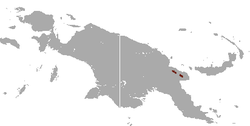 | Size: 29–67 cm (11–26 in) long, plus 24–57 cm (9–22 in) tail [109] Habitat: Forest and grassland [114] Diet: Grass, leaves, shoots, seeds, and fruit [111] | EN
|
| Red-legged pademelon | T. stigmatica (Gould, 1860) Four subspecies
| Eastern Australia and southern New Guinea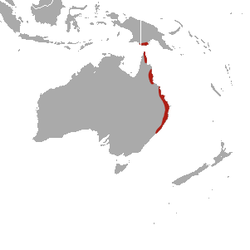 | Size: 38–54 cm (15–21 in) long, plus 30–48 cm (12–19 in) tail [115] Habitat: Forest [116] Diet: Leaves and fruit, as well as grass, bark, fungi, and cicadas [115] | LC
|
| Red-necked pademelon | T. thetis (Lesson, 1828) | Eastern Australia | Size: 29–63 cm (11–25 in) long, plus 27–51 cm (11–20 in) tail [117] Habitat: Forest [118] Diet: Grass, leaves, shoots, seeds, and fruit [111] | LC
|
| Tasmanian pademelon | T. billardierii (Desmarest, 1822) | Tasmania  | Size: 29–67 cm (11–26 in) long, plus 24–57 cm (9–22 in) tail [109] Habitat: Forest, shrubland, and grassland [119] Diet: Grass, leaves, shoots, seeds, and fruit [111] | LC
|
| Common name | Scientific name and subspecies | Range | Size and ecology | IUCN status and estimated population |
|---|---|---|---|---|
| Swamp wallaby | W. bicolor (Desmarest, 1804) | Eastern Australia | Size: 66–85 cm (26–33 in) long, plus 64–87 cm (25–34 in) tail [120] Habitat: Forest and shrubland [121] Diet: Buds, ferns, leaves, shrubs, and grasses, as well as bark and shoots from needle-leaf trees [120] | LC
|
Subfamily Sthenurinae
| Common name | Scientific name and subspecies | Range | Size and ecology | IUCN status and estimated population |
|---|---|---|---|---|
| Banded hare-wallaby | L. fasciatus (Péron & Lesueur, 1807) Two subspecies
| Western Australia | Size: 40–46 cm (16–18 in) long, plus 32–40 cm (13–16 in) tail [122] Habitat: Shrubland [123] Diet: Plants and fruit [122] | VU
|
Potoroidae
| Common name | Scientific name and subspecies | Range | Size and ecology | IUCN status and estimated population |
|---|---|---|---|---|
| Rufous rat-kangaroo | A. rufescens (Gray, 1837) | Northeastern Australia | Size: 37–52 cm (15–20 in) long, plus 35–40 cm (14–16 in) tail [124] Habitat: Forest and savanna [125] Diet: Grass, herbs, roots, tubers, and fungi, as well as carrion bones and larvae [124] | LC
|
| Common name | Scientific name and subspecies | Range | Size and ecology | IUCN status and estimated population |
|---|---|---|---|---|
| Boodie | B. lesueur (Quoy & Gaimard, 1824) | Scattered western and southern Australia | Size: 37–40 cm (15–16 in) long, plus about 30 cm (12 in) tail [126] Habitat: Forest, savanna, shrubland, and desert [127] Diet: Leaves, seeds, fruits, nuts, tubers, bulbs, flowers, and fungi, as well as termites and marine carrion [126] | NT
|
| Desert bettong† | B. anhydra Finlayson, 1957 | Central Australia | Size: Unknown [128] Habitat: Unknown [128] Diet: Unknown [128] | EX
|
| Eastern bettong | B. gaimardi (Desmarest, 1822) | Eastern Tasmania | Size: 32–33 cm (13–13 in) long, plus 32–33 cm (13–13 in) tail [129] Habitat: Forest [130] Diet: Fungi, as well as plants [129] | NT
|
| Northern bettong | B. tropica Wakefield, 1967 | Northeastern Australia | Size: 27–44 cm (11–17 in) long, plus 26–35 cm (10–14 in) tail [131] Habitat: Forest [132] Diet: Fungi, as well as roots, tubers, small invertebrates, and seeds [132] | EN
|
| Nullarbor dwarf bettong† | B. pusilla McNamara, 1997 | Southern Australia | Size: Unknown [133] Habitat: Unknown [133] Diet: Unknown [133] | EX
|
| Woylie | B. penicillata (Gray, 1837) | Scattered western and southern Australia (form distribution in yellow) | Size: 30–38 cm (12–15 in) long, plus 29–36 cm (11–14 in) tail [134] Habitat: Forest and shrubland [135] Diet: Fungi, as well as bulbs, tubers, seeds, insects and resin [134] | CR
|
| Common name | Scientific name and subspecies | Range | Size and ecology | IUCN status and estimated population |
|---|---|---|---|---|
| Desert rat-kangaroo† | C. campestris (Gould, 1843) | Central Australia | Size: 25–29 cm (10–11 in) long, plus 29–38 cm (11–15 in) tail [136] Habitat: Desert [137] Diet: Leaves and stems, as well as insects [138] | EX
|
| Common name | Scientific name and subspecies | Range | Size and ecology | IUCN status and estimated population |
|---|---|---|---|---|
| Broad-faced potoroo† | P. platyops (Gould, 1844) | Southwestern Australia | Size: 24–42 cm (9–17 in) long, plus 19–33 cm (7–13 in) tail [139] Habitat: Inland wetlands [140] Diet: Fungi, grass, roots, and other vegetation [139] | EX
|
| Gilbert's potoroo | P. gilbertii (Gould, 1841) | Southwestern Australia | Size: 24–42 cm (9–17 in) long, plus 19–33 cm (7–13 in) tail [139] Habitat: Shrubland [141] Diet: Believed to be roots and fungi [142] | CR
|
| Long-footed potoroo | P. longipes Seebeck & Johnston, 1980 | Southeastern Australia | Size: 24–42 cm (9–17 in) long, plus 19–33 cm (7–13 in) tail [139] Habitat: Forest and shrubland [143] Diet: Fungi, as well as insects, seeds, and plants [144] | VU
|
| Long-nosed potoroo | P. tridactylus (Kerr, 1792) Two subspecies
| Southeastern Australia and Tasmania | Size: 24–42 cm (9–17 in) long, plus 19–33 cm (7–13 in) tail [139] Habitat: Forest and shrubland [145] Diet: Fungi, insects, grass, roots, and other vegetation [139] | NT
|

